論説

概要
- Consumer-to-business payments will increase 6% over the next five years, we project, including growth in digital wallets, account to account, and cards.
- Competition is intensifying for retail merchant and consumer accounts, and as much as 90% of today’s retail payments revenue is at risk of changing ownership to independent software vendors, major technology firms, and others.
- Emerging web3 applications could open participation in payments to a much broader swath of nonfinancial businesses and consumers.
- Incumbent banks and card schemes need to substantially revise their strategy, marketing and sales programs, and technology investments.
Retail payments is a rich and promising industry, earning what Bain & Company estimates as $356 billion in global revenue in 2021, with projected annual growth of 6% to $480 billion by 2026 (see Figure 1). It’s not just alternative payment methods such as digital wallets and account-to-account arrangements that are growing; traditional credit and debit cards are still thriving (see Figure 2). Consumers in many markets continue to replace cash, while cards are expanding in major developing markets such as India and Brazil despite the introduction of real-time account-to-account payments infrastructure by central banks.
The retail payments industry is projected to grow steadily in most regions
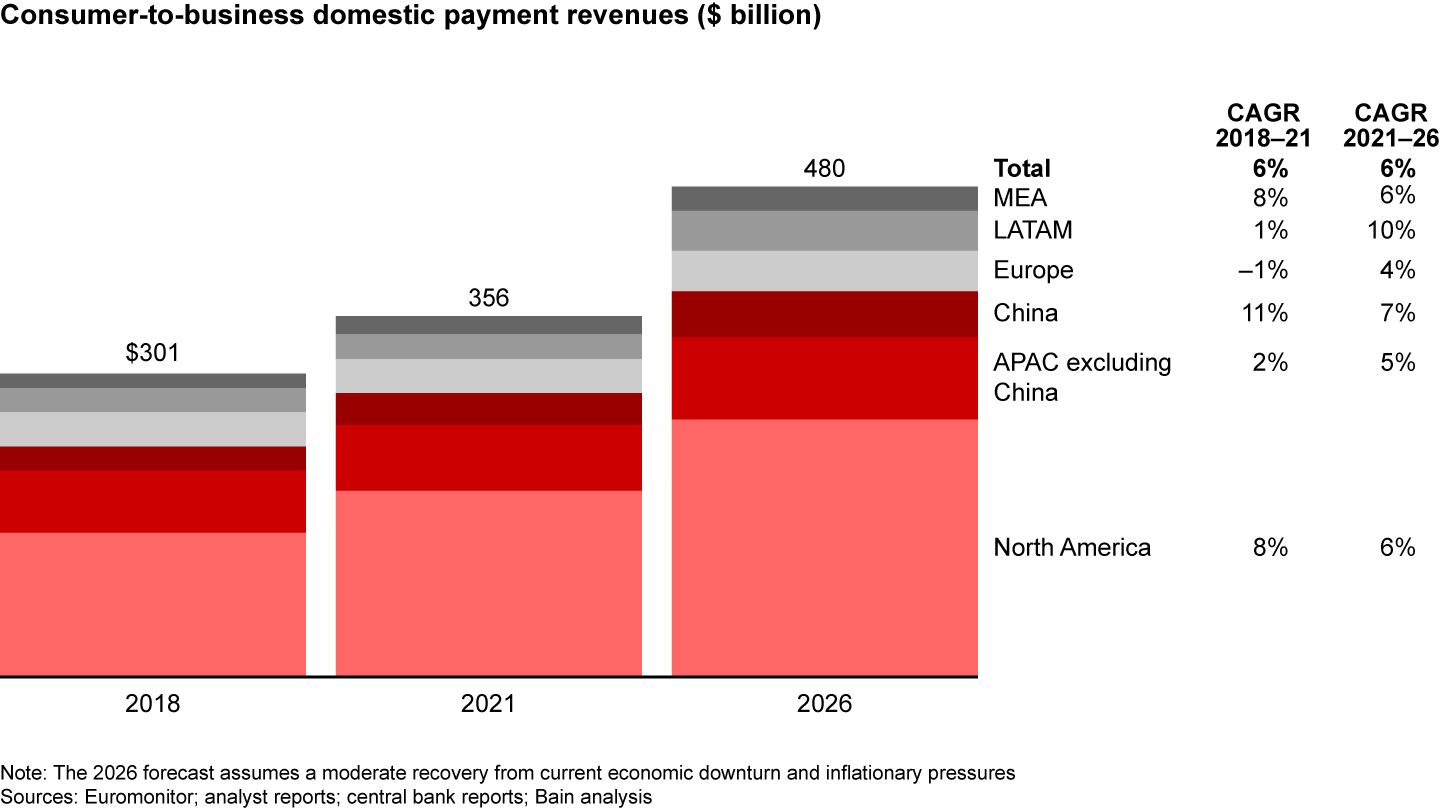
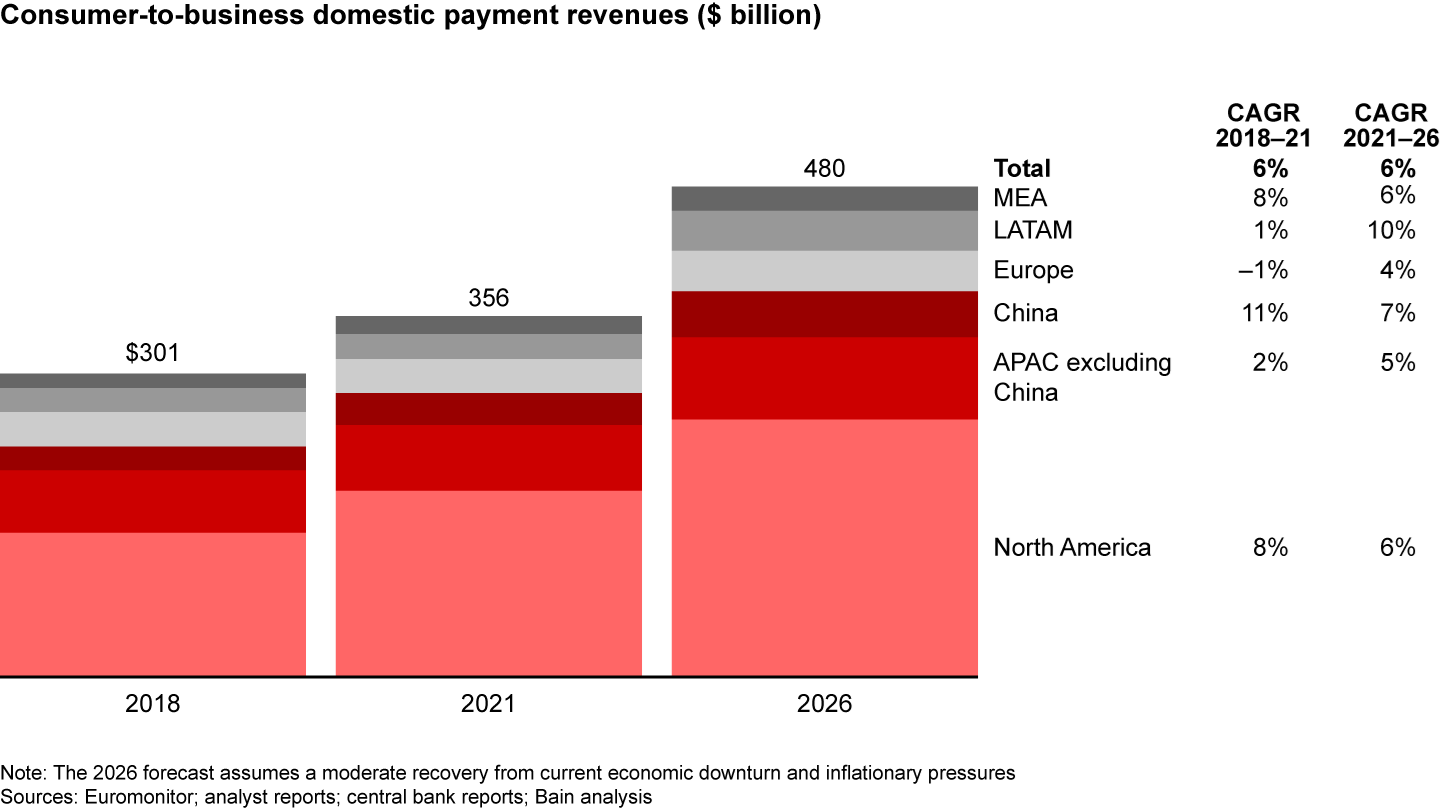
Digital payments continue to replace cash and paper
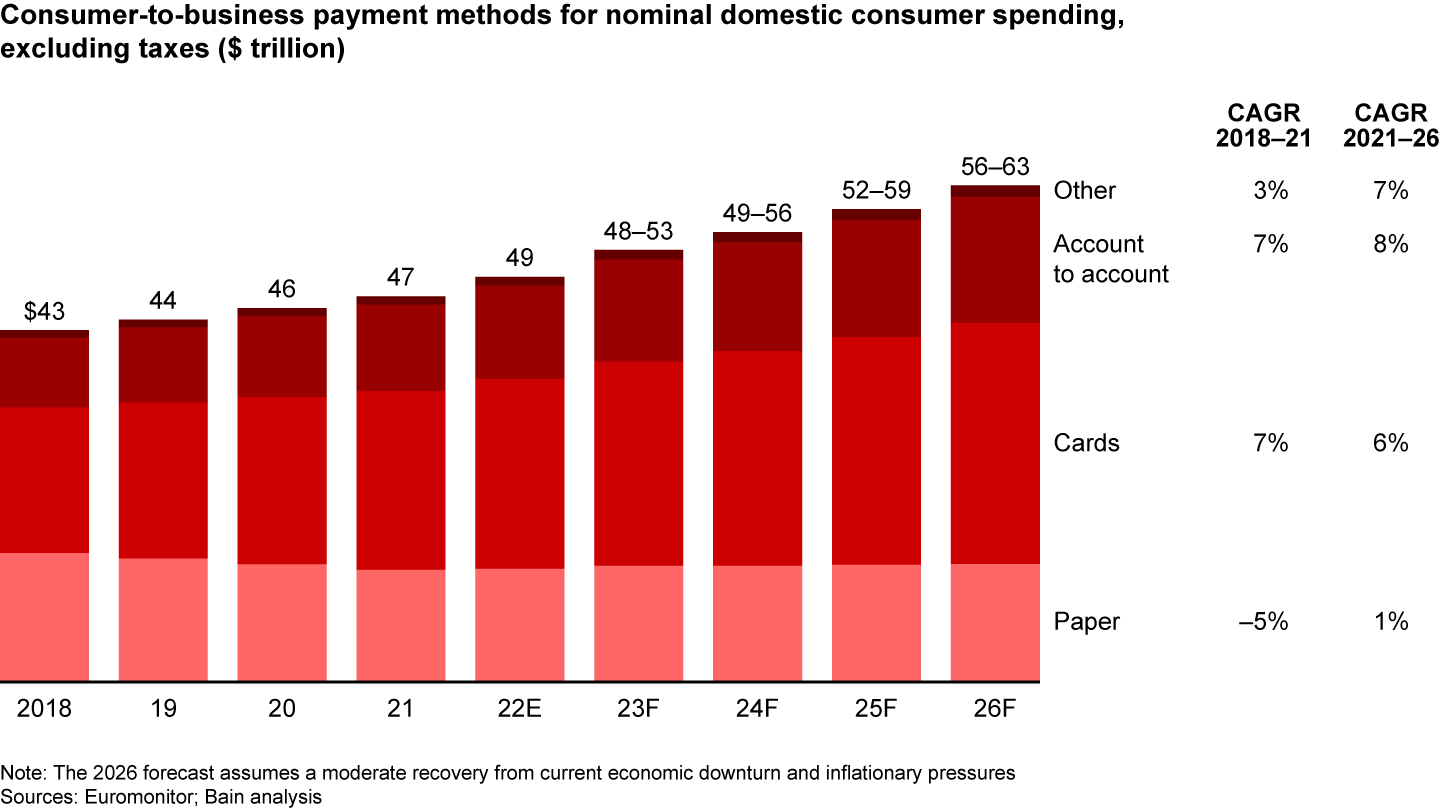
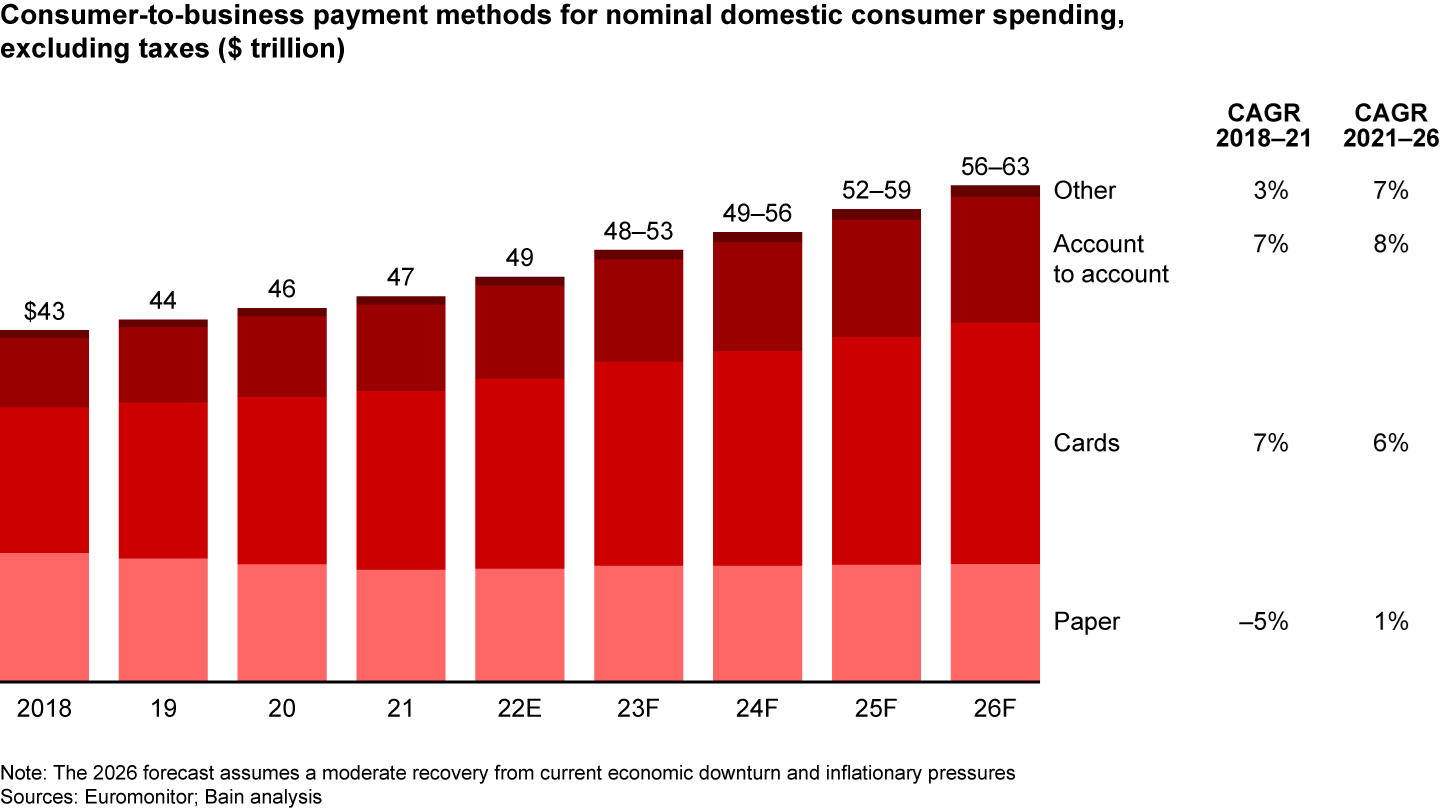
Yet behind the overall growth trend, competition has intensified for retail merchant and consumer accounts. Over the next decade, we expect software companies and major technology firms to take a material share of payment origination volume and revenues in many markets. We estimate that as much as 90% of today’s payments revenue is at risk of changing ownership. To fend off innovative insurgents and stay relevant to customers, incumbent banks, processors, and card schemes will be forced to substantially revise their strategy, marketing and sales programs, partnerships, and technologies.
Software plus payments: better together
The momentum of embedded finance to merchants demonstrates the value of a “better together” proposition of software and payments. We estimate that US payments revenues flowing through independent software vendors (ISVs) such as Lightspeed and Toast will grow 66% to $17.4 billion by 2026 (see Figure 3). The rollout of ISV offerings will be slower in the UK and EU because of the fragmented, local-language nature of European markets.
Independent software vendors will grow through strong merchant relationships

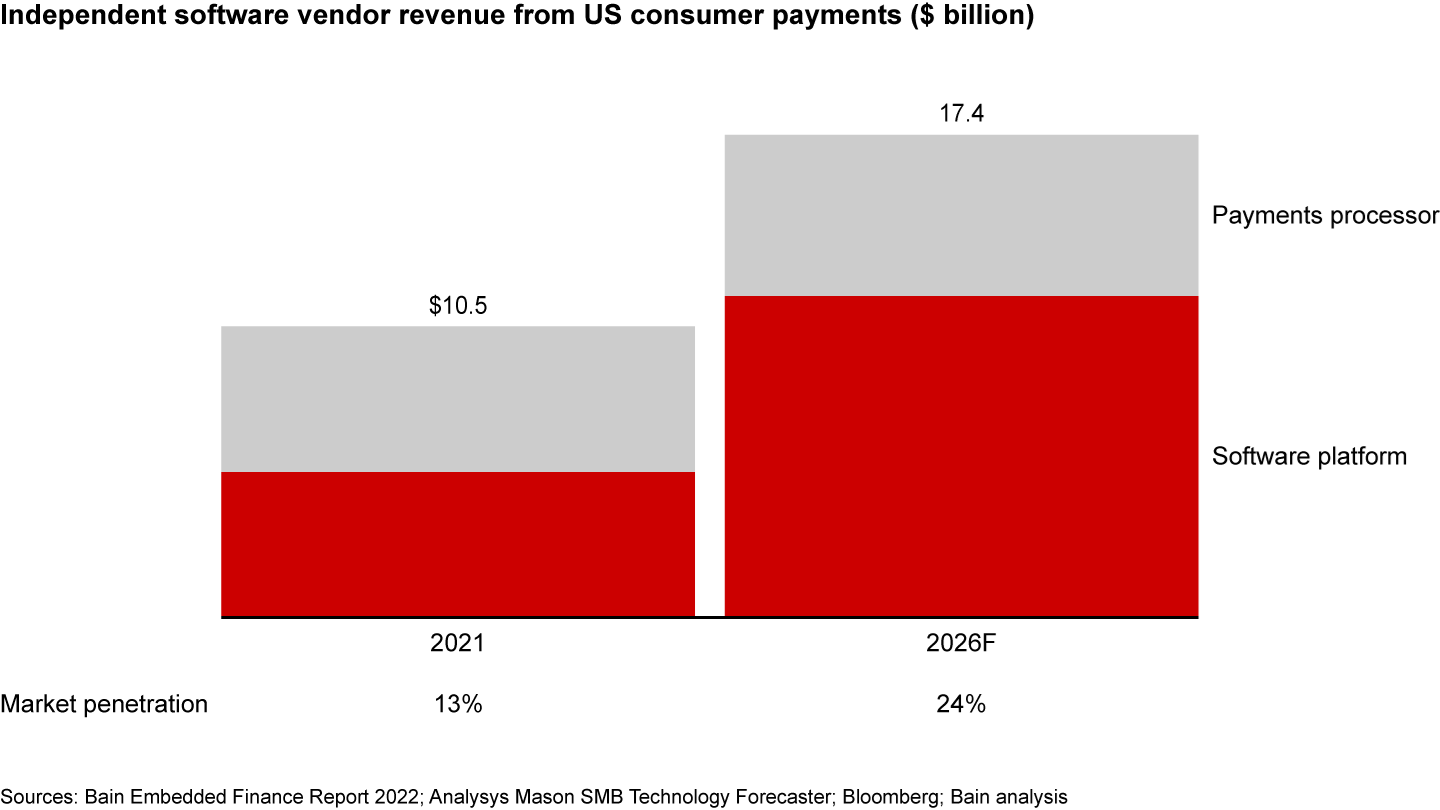
Major technology firms have also launched payments businesses, poaching profit pools, bringing down prices to merchants, and carving out e-wallet positions that help them own the customer relationship. Some, such as Apple and Google, are now using proprietary payment methods to good effect. Apple Pay, for instance, ranks second in Net Promoter Score℠, trailing only PayPal among digital wallets, and half of Apple Card users age 25 to 34 cite it as their main credit card, a Bain NPS Prism® survey found.
Yet even these tech and card powerhouses face challenges as government regulators have stepped up oversight, slowing the expansion of these companies into payments. Meta, parent of Facebook and Instagram, moved aggressively into payments for a number of years, including the push to enable payments through its WhatsApp platform in India and Brazil. However, delayed approval and stalled rollout restrictions have dampened WhatsApp Pay’s entry into these markets.
Account to account is here to stay
Central banks and regulatory agencies will continue to promote development of public payments infrastructure to enable viable alternative to cards and hasten the replacement of cash. India’s government, for instance, launched the Unified Payments Interface in 2016, and its ongoing enhancements have helped transaction value to grow steadily and displace cash, mostly from peer-to-peer and small-ticket transactions. Pix in Brazil has taken a similar trajectory, forming the backbone for new payment products and facilitating the replacement of cash with electronic payments, which will be further advanced through the recent payment initiation service of the Open Finance platform.
Web3 could further change the game
Emerging web3 applications could further spur a new generation of technologies to move money, opening participation in payments to a much broader swath of nonfinancial businesses and their consumers.
Web3 tools include digital wallets that enable persistent digital identity and high-capacity blockchain-based processing platforms, as well as features such as smart contracts that will likely enhance efficiency and functionality. The first commercially viable and scalable uses are already emerging. While consumer applications such as paying with cryptocurrency will generate the most publicity, a quieter and more profound shift will unfold in wholesale money movement among banks and large companies. The earliest areas of disruption likely will be funds settlement, peer-to-peer money movement, and cross-border remittances.
A wide variance in card use by country
Cards will remain the largest payment revenue pool for years to come, but their growth will slow.
Our analysis projects that global consumer card payment volume will grow about 6% annually through 2026. But that’s lower than the 7% annual growth since 2018 and the 8% annual growth we project for account to account.
Moreover, card volume will have varying trajectories in different country markets.
- Card-heavy and high-interchange markets. The high cost of cards in the US, for instance, should propel growth in alternative payments, causing card growth to slow. We expect US credit and debit cards to peak at just over 80% of transaction value in 2029, based on current trends (see Figure 4). Cards usage may peak earlier if consumers accelerate adoption of alternative payments.
- Card-heavy and low-interchange markets. In the UK, France, Germany, Australia, and several other markets, cash has been almost completely displaced. The fees that merchants pay to card companies are low, so incentives to switch to alternative electronic payments are weaker, causing cards to maintain their share.
- Cash-displacement markets. In India and Brazil, we expect significant electronic payments growth, with account-to-account rails—the part of the network infrastructure that enables digital money transfers—becoming stronger, eventually achieving greater share than cards.
- Entrenched digital wallets. China is a notable example of a market where cards growth will continue through digital wallets as well as standalone card transactions.
US card penetration is expected to peak in 2029 at just over 80% of transaction value
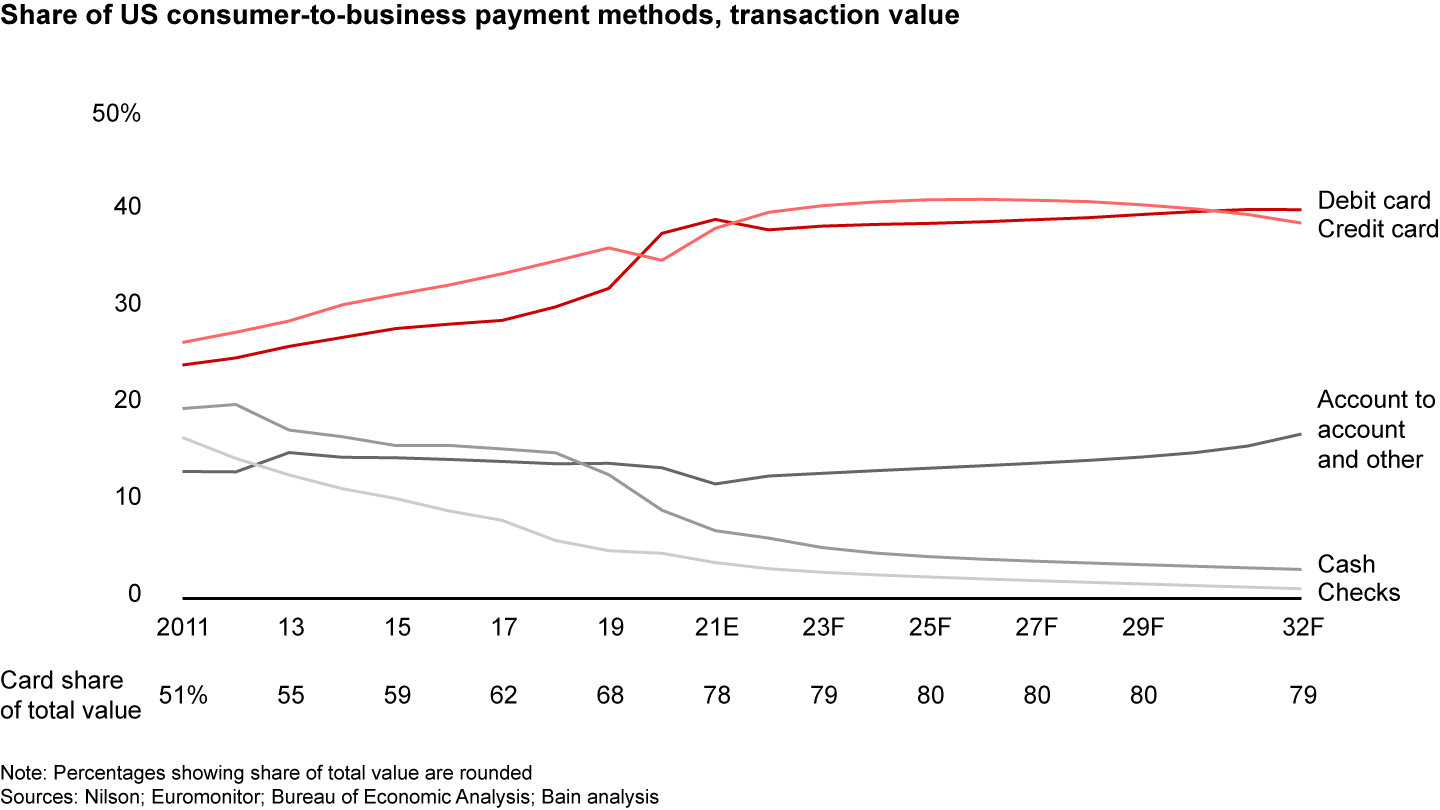
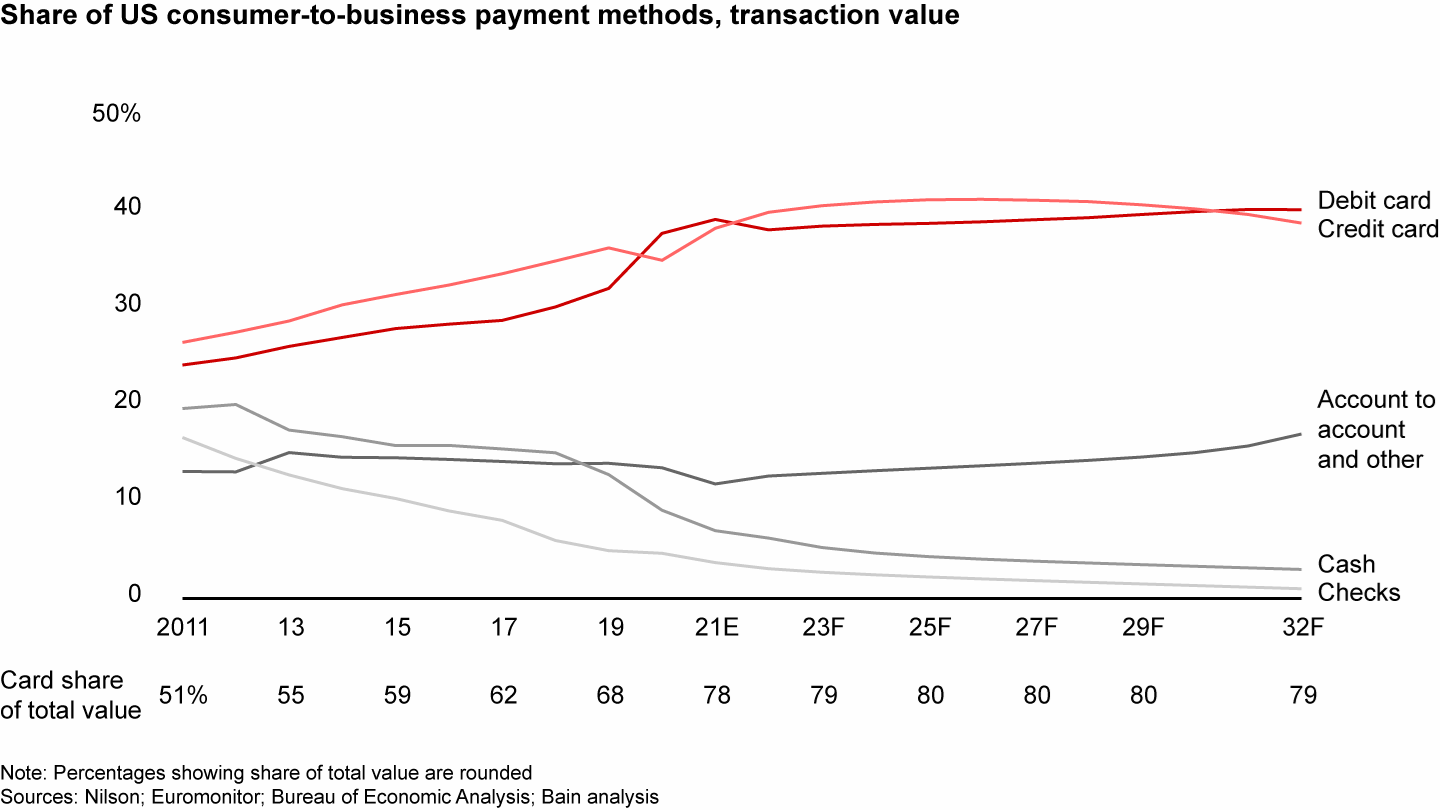
Continued replacement of cash will increase cards’ revenue through higher card penetration. But the spread of account-to-account digital payments will limit cards’ growth over the long term. The challenge for card companies thus will be to develop and expand services beyond simple transaction processing and eventually become agnostic to payment type.
A no-regrets, fourfold program
The high degree of change ahead for consumer-to-business payments has implications for traditional competitors. Banks can build defenses against big technology firms by investing more in the user experience. They should prepare for account-to-account payments, becoming rail agnostic to protect connected lending streams, even if that means cannibalizing card transaction revenues.
For card schemes, new sources of international growth will be essential, adding valuable services such as fraud management and tapping into underserved or new uses. They need to become payment-type agnostic and reinvent their businesses to facilitate and provide value-added services that complement crypto and account-to-account transactions as well as cards. They could partner with large tech firms to keep scheme credentials at the top of the consumer’s wallet, with a seamless customer and merchant experience defending against the shift to account-to-account offerings.
Bain’s work with banks, payment schemes, and established payments firms has identified four key areas that demand a sharper focus.
Strategy with a future-back perspective. Amid such fast-paced change, it may seem impossible to know which payment methods consumers will prefer several years in the future. But a future-back approach to strategy, which defines the desired future state and then works backward to establish tangible, practical milestones, can help identify and seize new opportunities.
Breakthrough insights come from examining extreme but plausible scenarios, such as consumers delegating purchases to artificial intelligence–powered avatars. Early adopters have created plugins for ChatGPT, the artificial intelligence chatbot developed by OpenAI, which enables purchasing based on the model’s recommendations. The goal here is not to understand which outcome is most probable but to uncover different ways to compete and win given a plethora of possible outcomes and to reveal moves that should prove worthwhile under most scenarios.
As part of this approach, the investment approval process will need to get simpler to allow for quick redeployment of capital. And because retail payments require a breadth of capabilities and an extensive reach, companies will want to shore up their competence in acquisitions and partnerships.
Highly targeted sales and marketing. Retail payments, like many other industries, has put a greater premium on personalization and nuanced customer segmentation. A restaurant, for instance, clearly needs a different payments proposition than a legal firm. New generative language AI models will further improve personalized marketing. For each segment, banks and card schemes will have to equip the sales team with the relevant playbooks that are continually enhanced and field-tested. It’s also critical to know where the money is, so a data-driven assessment of opportunities will ensure that companies focus on the highest-value market spaces.
Technology transformation, not incremental tweaks. Legacy stacks and infrastructure will have to be replaced by more flexible systems to accommodate always-on real-time payments, web3, and related new payments technologies. Companies should consolidate technical platforms and integrate acquired businesses to avoid bloated “keep the lights on” spending. They can then speed up product development by restructuring any code monoliths into a microservices architecture and investing in the processes and tooling to support a modern platform architecture.
Selective cost reductions. Most established firms will be forced to reckon with shrinking profit margins and the need to dramatically reduce operating costs. Neglected areas such as operations, customer support, and compliance will require investments in systems upgrades and automation. Unresolved technology debt, unintegrated acquisitions, and incoherent platform architecture will compete with growth initiatives at a time when investment in technology resources will be harder to come by as shrinking profit margins squeeze the amount of funding available.
* * *
Young firms will keep on innovating and making incursions, so traditional firms cannot count on riding a wave of overall payments growth. Now is the time to determine where to play and how to win in those chosen spots. Getting clear on where and how to outcompete, as well as which leaps in capabilities to make, is essential to staying relevant in a fast-changing industry.

Bain + OpenAI
《6/1発行の生成AI導入の現状に関する日本と海外を比較分析したレポートは、
このサイト下部の講演実績のリンクよりダウンロード頂けます》
近年のテクノロジーの進化、特に生成系AIへの関心の高さには目を見張るものがあり、この新たな技術が何をもたらすのかについて、世界中のメディアが競うように取り上げています。優れた技術を持つOpenAIと、高度なビジネス戦略と社会的責任に対する深い知見をもつベインとの提携により、今後生成系AIがビジネスにどのように活用できるか、また、その可能性がどのように広がっていくのかが明確になるでしょう。
Hear from leaders at Bain, OpenAI, and Coca-Cola as they discuss the business impact of this strategic alliance
生成系AIは高度な機械学習モデルを活用することにより、まったく新たな画像、文章、音声などのコンテンツを生み出します。ChatGPT、DALL·E、Codexなどのプラットフォームは、人の心を引き付けるような目新しさ以上に、マーケティングの高度なパーソナライズ化、コンテンツ作成やカスタマーサービスの効率化など、業界や事業部門を越えて恩恵をもたらします。ニューラルネットワークの進歩によって生成系AIは転換点を迎えており、いち早く導入した企業にとっては成功を掴むための絶好の機会となるでしょう。しかし、生成系AIの技術が勢いを増している一方で、既存システムとの統合で困難に直面している企業も多数存在します。
ベインは、バリューチェーン全体にわたる価値創出の支援経験やクライアントの業界に対する深い知見を生かして、生成系AIの実用的用途と誇大に強調された機能を切り分ける支援も行います。AIに関する高い専門知識を備えたベインのアドバンスド・アナリティクス・プラクティスチームは、提言だけでなくソリューションも提供します。生成系AIを活用することにより価値の最大化が見込まれる事例を特定し、概念実証(PoC)を迅速に実施した後、オペレーションモデル、ビジネスプロセス、データ資産にケイパビリティを適用させていきます。
新たな技術の採用には慎重に検討を重ねる必要があることを踏まえ、ベインでは、倫理、権利、所有権に関するアドバイスの提供も行っています。また、エンドユーザーが推奨者や支持者になるよう、チェンジマネジメント戦略の策定と実行も支援します。OpenAIとの提携により、クライアント企業が喫緊の課題を解決するための支援を行うだけでなく、一歩抜きんでて競争力を獲得することに貢献します。
大きな変革を伴う技術は、実際に活用されてこそ本来の力を発揮します。カスタマーセンターの強化や、ダイレクトマーケティングのターゲットをより明確に絞りたい場合など、OpenAIとの提携によりもたらされる技術や実績に基づき、クライアントが最適なタイミングを逃さず競争優位を確保するための支援が可能です。ベインは、クライアントがこの革新的な技術を獲得し、フルポテンシャルを発揮するためのロードマップをつくれるように支援しています。